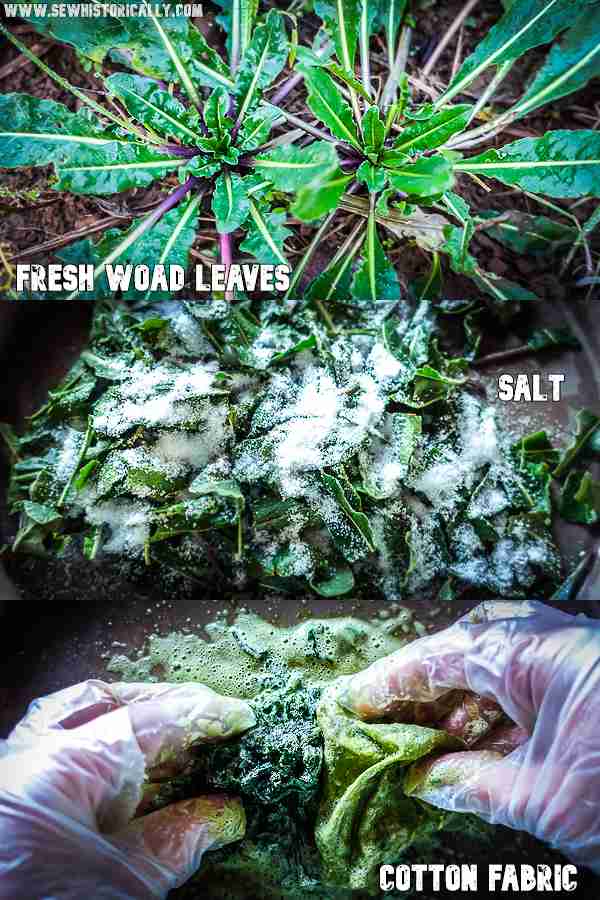Learn how to dye with fresh woad leaves without using hazardous chemicals.
After dyeing cotton fabric & clothes blue with red cabbage and black beans, my next natural dye experiment is dyeing cotton fabric blue with homegrown fresh woad leaves. However, I don’t want to use the common woad vat with hazardous chemicals. So after some internet research I found 5 promising natural woad dye recipes without hazardous chemicals: Two of them are traditional fermentation vats, one uses stale urine, one uses salt and one uses vinegar.
Related: How To Dye Cotton Blue With Red Cabbage (No Mordant)
By the way, if you don’t have time to dye immediately with your homegrown fresh woad leaves, you can pound the fresh woad leaves, form the pulp into balls and let the woad balls ferment for some time. Or you can also rake the pounded woad leaves in heaps, sprinkle them with water or urine from time to time, and let them ferment for a day up to some months according to different sources. You can use the fermented woad balls later for dyeing.
Related: How To Dye With Woad & Indigo – Historical Dye Recipes
5 Ways How To Dye With Fresh Woad Leaves
How To Dye With Fresh Woad Leaves
Tear or pound the fresh woad leaves. Add almost boiling water and some alkali like lime, washing soda, potash, wood ash lye or fresh or stale urine. Then dip the fabric in the vat for 1 hour (or up to 12 hours), air and let it dry, then redip it if necessary. (Woad dye recipe adapted from Journal of Archaeological Science)
Related: How To Dye Cotton Blue With Red Cabbage (DIY Iron Mordant, Cold Method)
How To Dye With Fresh Woad Leaves – Salt Extraction Method
The salt extraction method seems to be a new method to dye with fresh woad leaves. You tear up the fresh woad leaves, sprinkle salt over the leaves and knead the woad leaves together with the fabric you want to dye. (Woad dye recipe adapted from Marina Skua)
I dyed cotton fabric and linen yarn which produced a green color on both. However, even after letting the fabric and yarn dry for a day the green color didn’t turn blue. So I rinsed the fabric in water and soap and let it dry. During rinsing the dark olive green faded to a pale green. But I don’t know yet how lightfast and washfast the green color is: I’ll keep you updated!
How To Dye With Fermented Woad Balls
Break up the fermented woad balls, add hot water & alkali (like lime, potash, washing soda or urine) until PH 8.5-9 (or even 10). Keep the vat at 50°C. Stir the fermenting vat from time to time. Also control the temperature and PH (and add more alkali if necessary). You can also add madder, bran, honey, yeast, beer or weld to accelerate the fermentation. After about one or one and a half day, the vat should be ready for dyeing. Dip the fabric for half an hour to one hour in the vat, air it for the same amount of time, then redip it if necessary. (Woad dye recipe adapted from Journal of Archaeological Science)
Related: How To Dye Cotton Green With Red Hazelnut Leaves (No Mordant)
Woad Fermentation Vat With Urine
Stale urine was often added to woad fermentation vats because it contains alkali and bacteria necessary to achieve a blue dye. It was also readily available and cheap. To make the urine vat, combine stale urine and pounded fresh woad leaves (or fermented woad balls) and keep the vat at 50°C. If the fermentation is too lively, calm it by adding some alkali like lime or washing soda. After about one week, the vat should turn greeny-yellow and is ready for dyeing. (Woad dye recipe adapted from Journal of Archaeological Science & various historical dye recipes from the 1700s & 1800s)
Woad Dye With Vinegar
I’ve read on the internet that you can also extract dye from fresh woad leaves using cold water and vinegar. I tried it. But it didn’t work on vegetable fibers like cotton and linen. However, it obviously works on animal fibers like wool and silk (but I haven’t tried it yet). (Woad dye recipe adapted from Jenny Dean’s Wild Colour)
Related: How To Dye Cotton Fabric Black Naturally
Please Pin It!


thank you for this! natural dye technology is so interesting. also, thanks for mentioning the difference in performance on vegetable versus animal fibres. super useful and surprisingly often lacking from other entry-level dye discussions.
Thank you! Glad you liked it! 😀